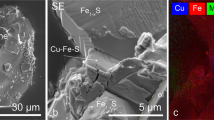Abstract
Of the many meteorites recovered so far from the Allan Hills, Antarctica, only nine have been irons. One of these, ALHA77283, contains troilite(FeS)–graphite(C)–schreibersite((Fe,Ni)3P)–cohenite(Fe3C) inclusions rich in the carbonado-type diamond–lonsdaleite ‘nodules’ previously described from the Canyon Diablo meteorite1,2. The Canyon Diablo, Arizona, meteorite, the excavator of Meteor Crater, is the only other iron meteorite known to contain these high-pressure minerals, and their occurrence in that meteorite has been explained as the result of shock-induced transformation of graphite, most probably at the moment of terrestrial impact and disintegration of the projectile during crater formation3–6. The suggestion7 that formation was by high gravitational pressure has not been accepted. Virtually identical diamond–lonsdaleite-containing material in ALHA77283 occurs in a meteorite specimen with a well developed heat-altered zone produced by atmospheric ablation. It seems, therefore, that the diamond and lonsdaleite were present in the meteoroid before its final ablative passage through the atmosphere and soft landing on the ground. The shock event that produced these high pressure phases, therefore, must have taken place on its parent body or have been associated with the disruption of that body. Here we present the metallographic and X-ray diffraction data on which this conclusion is based.
This is a preview of subscription content, access via your institution
Access options
Subscribe to this journal
Receive 51 print issues and online access
$199.00 per year
only $3.90 per issue
Buy this article
- Purchase on Springer Link
- Instant access to full article PDF
Prices may be subject to local taxes which are calculated during checkout
Similar content being viewed by others
References
Ksanda, C. J. & Henderson, E. P. Am. Miner. 24, 677–680 (1939).
Frondel, C. & Marvin, U. B. Nature 214, 587–589 (1967).
Nininger, H. H. Arizona's Meteorite Crater (American Meteorite Museum, Arizona, 1956).
Lipschutz, M. E. & Anders, E. Geochim. cosmochim. Acta 24, 83–105 (1961).
Heymann, D., Lipschutz, M. E., Nielsen, B. & Anders, E. J. geophys. Res. 71, 619–641 (1966).
Anders, E. & Lipschutz, M. E. J. geophys. Res. 71, 643–661 (1966).
Carter, N. L. & Kennedy, G. C. J. geophys. Res. 69, 2403–2421 (1964).
Clarke, R. S. Jr., Jarosewich, E., Goldstein, J. I. & Baedecker, P. A. Meteoritics 15, 273–274 (1980).
Jain, A. V. & M. E. Lipschutz. Chem. Erde. 30, 199–215 (1971).
Axon, H. J. & Couper, W. R. D. Mineral. Mag. 40, 827–841 (1976).
Buchwald, V. F. Handbook of Iron Meteorites (University of California Press, 1975).
Axon, H. J., Couper, W. R. D. & Kinder, J. Nature 267, 414–415 (1977).
Author information
Authors and Affiliations
Rights and permissions
About this article
Cite this article
Clarke, R., Appleman, D. & Ross, D. An Antarctic iron meteorite contains preterrestrial impact-produced diamond and lonsdaleite. Nature 291, 396–398 (1981). https://doi.org/10.1038/291396a0
Received:
Accepted:
Issue Date:
DOI: https://doi.org/10.1038/291396a0
This article is cited by
-
Impact diamonds from meteorite craters and Neogene placers in Ukraine
Mineralogy and Petrology (2022)
-
Shock-induced martensitic phase transformation of oriented graphite to diamond
Nature (1991)
-
Interstellar diamonds in meteorites
Nature (1987)
-
Diamonds are forever?
Nature (1987)
-
Disruption of meteoritic iron parent bodies
Nature (1981)
Comments
By submitting a comment you agree to abide by our Terms and Community Guidelines. If you find something abusive or that does not comply with our terms or guidelines please flag it as inappropriate.



